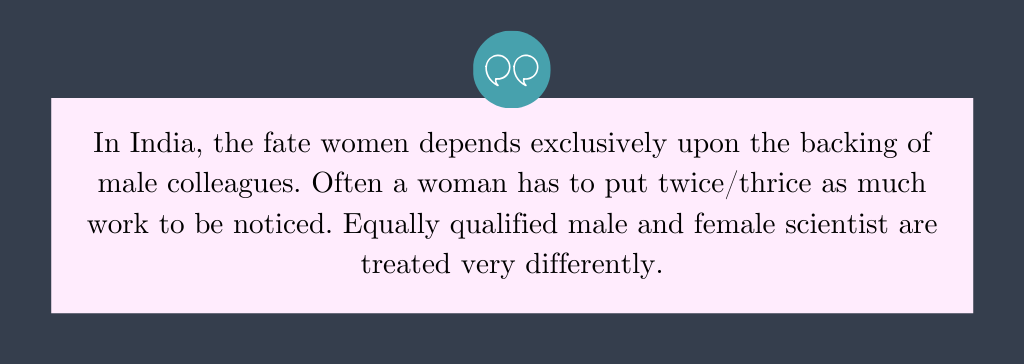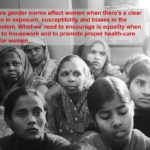A nick here and some pain there the first rescue is the unlicensed doctor in our homes – the grandmother/mother. But when we turn our heads around in the discipline of STEM the presence of our gender seems imperceptible.
The National Task Force on women in science report suggest that only 15% of the Indian Research and Development workforce are women, while the global average is 30%. Women have not just been caged by socio – economic barriers, but have also not been treated as human beings, how we can jump to them being respected in professional fields predominantly dominated by men.
Charles Darwin once said, “There seems to me to be a great difficulty from the laws of inheritance, (if I understand these laws rightly) in [women] becoming the intellectual equals of man.”
I am wondering who didn’t look at evolution within? But even after (still) bearing the brunt of suppressed and being kept away from acquiring knowledge, and putting it to use institutionally, women have been healers, unlicensed doctors, and counselors, cultivating healing herbs and exchanging the secret of their uses (Barbara Ehrenreich and Deirdre English 1972). They were/are still the autonomous independent midwives who travelled to bring to life “homunculus” and passing the knowledge and experience as heritage.
But the measure of achievements is also different for men and women.
Ours is determined by their spouses or how well or how soon they will be “settled”. It’s bizarre that men in position aren’t asked these questions, while we can’t stop asking women anything but this.
Janaki Ammal rejected a planned marriage to follow her passion for botany and hybridized India’s sugarcane varieties into a plant sweet enough to grow into a 30-million-ton-a-year industry. Although her work was often ignored by male colleagues, she was awarded the Padma Shri.
The doors of sciences are wide open for women, but the conspicuous and inconspicuous sexism and misogyny in the field is persistently sad.
Foucault argues that power and knowledge are not seen as independent entities but are inextricably related, where knowledge is always an exercise of power and power always a function of knowledge. Hence, when an institution (of science) is monopolised, here by a particular gender, then we can see the language of power speaking; where women are highly under represented and it has gone unacknowledged for quite long, at the cost of social justice.
Chien-Shiung Wu, the Chinese-American physicist helped develop the process for breaking down uranium into isotopes during her work on the Manhattan Project, which produced the first nuclear weapons during World War II. The other experiments that she conducted resulted in Nobel Prize in Physics (1957), which was awarded to two of her male colleagues – Tsung-Dao Lee and Chen Ning Yang, with no acknowledgement of her contribution.
Similar was the case of Rosalind Franklin, the English chemist presented her x-ray diffraction photo showing crystallized DNA fiber; the three men won the Nobel Prize in Physiology or Medicine, without mention of her work, in 1962.
The gender lines that are drawn early seeps from biological lines to sociological ones, and it manifests into exclusions of women in all realms which leads to the creation of a false belief that women do not belong.
It becomes necessary for women to rise up and enable and inspire others like –
Phyllis Bolds, the African-American physicist, whose work was instrumental in mitigating adverse physical effects on military aircraft, personnel, and cargo. She further tutored students in STEM to inspire several of her female to become scientists.
Dr. Aditi Pant, who dwelled into the oceans of the Antarctic to become one of the first Indian women to visit the icy continent Antarctic for which she was honoured with the Antarctica Award, along three more champions – Sudipta Sengupta, Jaya Naithani and Kanwal Vilku for their outstanding contribution to the programme.
So why is there such a big gap between the genders when it comes to entering the sciences? According to Jayasree Subramanian, women are always combating gender-based prejudices and a very clear patronizing attitude at the workplace. When it comes to giving opportunities, women are always either given boring and repetitive work that men have no interest in or they are asked to do it in collaboration with their male colleagues.
These notions and prejudices are not just reproduced because of the way our society perceives ‘career-oriented women helps to cement the fact that for women, a career will be secondary to family. What is expected then is to have the same drive and the same ambition in the field of science to the point of forgetting about a family altogether. This leads to unwillingness to hire women because they might leave the field in favor of their family or giving them minimal and short-term autonomy so the larger picture doesn’t get affected if the women scientist leaves to get married.
In her essay, Subramanian says “Women enter the science institution with the same intellectual thirst and career ambitions as their male colleagues, hoping to be treated as equals. A senior woman scientist, who is seen as successful, insists that ‘unlike some of the male scientists who may be doing science because of the social pressures on them to have a respectable job and earn a living, the only reason I am doing science is because I am truly interested in it. There is no other reason or purpose’. Women make conscious choices that would help them remain in science: remaining single or marrying a scientist, carefully timing pregnancies and enlisting the support of their husbands and extended family to handle the domestic responsibilities when the children are young.”
This blatant discrimination is present across sectors, but in sciences the prejudice is far more relevant and hypocritical. Women have pointed out that when it comes to their work, even publications, the credit still lies with men. Men also leave their jobs just as often as women, especially for better paying opportunities. This is rewarded and talked about in terms of ambition and advancement in career. The same in case of women is seen as lack of commitment.
A woman said “Women never bloom to the full. Right from the beginning if I had encouragement I would have done much better. How much can one fight? Many women burn out. Women who have put in many years of hard work doing science give up. They stay back and keep home. It could have happened to me too. It is true if I had stayed back home I would have got used to it, but then the basic me would be dead.”
The problem of under-representation, not being given proper credit and having no scope for promotions have led women to actually turn ‘feminist’ after joining the sciences. What has specifically affected their will to fight is to witness discrimination in terms of their dedication to science. While men get married and have families, they’re still given merits for their dedication to the field despite having a family. When women get married and have families, they’re given no jobs because they will not be able to spend as much time in the office, their work is always questioned, and for it to be considered without doubt, needs to have a male participant as well.





